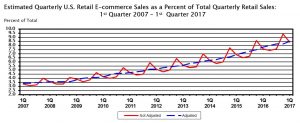Many of the headlines in the news about brick and mortar retail suggest this method of spending is becoming extinct and that many consumers are using solely electronic means to purchase goods. Even a word as dramatic as “apocalypse” has been used to describe the situation, as you will see later in this post. In reality, however, only 8.4% of total sales in the first quarter of 2017 were attributed to e-commerce, according to the U.S. Census Bureau’s quarterly retail report.
E-commerce sales are defined by the U.S. Census Bureau as the “sales of goods and services where the buyer places an order, or the price and terms of the sale are negotiated, over an Internet, mobile device (M-commerce), extranet, Electronic Data Interchange (EDI) network, electronic mail, or other comparable online system. Payment may or may not be made online.”
Again, just 8.4% of total sales came from e-commerce in Q1 of 2017. Many of us are no doubt surprised to see such a low percentage, given all the hype surrounding e-commerce. The reason e-commerce has received so much attention may be evident from the chart below: there has been steady growth since 2007 of e-commerce as a percent of total quarterly retail sales — evident whether viewing adjusted or not-adjusted sales.

The growth of e-commerce is undeniable, but that does not necessarily mean other ways of consuming have become irrelevant. Successful retailers are simply changing with the times as detailed in the May 19, 2017 CNBC article, Why predictions of a ‘retail apocalypse’ are overblown.2 The author Richard Levine makes the case that consumers now demand to be entertained more than ever, and this is changing how stores should be approaching their customers. Accordingly, “Brick-and-mortar is not in fact defunct. Instead, it is evolving, and successful retailers are embracing a shopping experience that blends a variety of platforms and ultimately creates the engagement necessary for a brand’s success.” He goes on to detail how certain retailers appeal to shoppers by incorporating showrooming, adding restaurants and offering interactive ways to experience the product including group classes. He concludes that “these brands recognize the new world of engagement, entertainment, excitement, and experience that the new shopper seeks.”
It is possible that these additions will still not result in an in-store purchase, but does that matter? If a sale is completed online after the in-store experience, the brick-and-mortar element still played a crucial role in completing the sale. As explained by Levine, “consumers enjoy the shopping experience without actually shopping: in many cases, they won’t bring home a purchase but instead buy online after enjoying the shopping experience. In the end, the brick and mortar assists the transaction that would not otherwise have occurred.”
Yes, brick and mortar stores may change, and certainly more will close if they cannot successfully appeal to consumers, but an apocalypse is far from likely.
